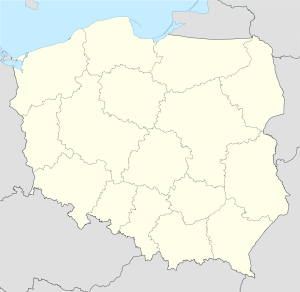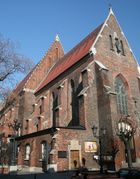Oświęcim
| Oświęcim | |||
|---|---|---|---|
 |
|||
|
|||
 Oświęcim
|
|||
| Coordinates: | |||
| Country | |||
| Voivodeship | Lesser Poland | ||
| County | Oświęcim County | ||
| Gmina | Oświęcim (urban gmina) | ||
| Established | First mentioned in 1117 | ||
| Town rights | 1291 | ||
| Government | |||
| - Mayor | Janusz Andrzej Marszałek | ||
| Area | |||
| - Total | 30.3 km2 (11.7 sq mi) | ||
| Elevation | 230 m (755 ft) | ||
| Population (2006) | |||
| - Total | 40,979 | ||
| - Density | 1,352.4/km2 (3,502.8/sq mi) | ||
| Time zone | CET (UTC+1) | ||
| - Summer (DST) | CEST (UTC+2) | ||
| Postal code | 32-600, 32-601, 32-602, 32-603, 32-606, 32-610 | ||
| Area code(s) | +48 033 | ||
| Car plates | KOS | ||
| Website | Oswiecim (English) | ||
Oświęcim (pronounced [ɔɕˈfjɛɲt͡ɕim] (![]() listen)) (German: Auschwitz, Yiddish Oshpitsin אָשפּיצין, Czech: Osvětim, Slovak: Osvienčim, Russian: Освенцим) is a town in southern Poland, situated 50 kilometres (31 mi) west of Kraków, near the confluence of the rivers Vistula (Wisła) and Soła.
listen)) (German: Auschwitz, Yiddish Oshpitsin אָשפּיצין, Czech: Osvětim, Slovak: Osvienčim, Russian: Освенцим) is a town in southern Poland, situated 50 kilometres (31 mi) west of Kraków, near the confluence of the rivers Vistula (Wisła) and Soła.

Historical Affiliations
Province of Kraków c. 1138-1179
Duchy of Opole 1179-
Duchy of Oświęcim 1315-1327
Kingdom of Bohemia 1327-
Dukes of Te and Grossglogau
Kraków Voivodeship 1457-
Kingdom of Galicia and Lodomeria 1772-1918
Second Polish Republic 1918-1939
Nazi Germany 1939-
Soviet occupation zone 1945-
People's Republic of Poland 1952-
Bielsko-Biała Voivodeship 1975-1998
Lesser Poland Voivodeship 1999-
(year wikilinks are to a corresponding wikiarticle)
Contents |
History
Following the Fragmentation of Poland in 1138, Casimir II the Just attached the town to the Duchy of Opole in 1179 for his younger brother Mieszko I Tanglefoot. The town was destroyed in 1241 during the Tatar invasions. Around 1272 the newly rebuilt town created a municipal charter modeled on those of Lwówek Śląski (a Polish variation of the Magdeburg Law). Throughout much of history, Germans and Poles lived together peacefully in the town. From 1315 the town was the capital of independent duchy. In 1327, John I, Duke of Oświęcim joined with a western part of Galicia (Central Europe), the Duchy of Oświęcim, and Duchy of Zator a vassal state attached to the Kingdom of Bohemia. In the 14th century the population declined. The portion of ethnic Germans in the town shrank and in 1457 the Polish king Casimir IV bought the rights to the town, which was attached afterwards to the Cracow Voivodeship. Jews, invited by Polish kings to settle in the region, had already become the majority of the population in the 15th century. The town also became one of the centres of Protestant culture in Poland.[2]
The town was destroyed again during the 1655 Swedish Deluge. When the Polish-Lithuanian Commonwealth was partitioned and dissolved in 1795, the borders of Russia and the Kingdom of Prussia were close to the town.
In the 1866 war between Austria and the Prussian-led North German Confederation, a cavalry skirmish was fought at the town, in which an Austrian force defeated a Prussian incursion.[3][4] On the eve of World War II there were about 8,000 Jews in the city, over half the population.[5]
World War II and post-war

In October 1939, Nazi Germany immediately annexed the area to the newly created General Government, and in 1940 used forced labor to build a new subdivision to house Auschwitz guards and staff. Nazis set up the Auschwitz concentration camp in the area, where between 1940 and 1945 approximately 1.1 million people, mostly Jews, were killed by the Nazis in the Auschwitz-Birkenau gas chambers.[6]
Four nearby facilities where Nazi crimes were committed against Jews and Poles were Auschwitz I, II, & III; and the Buna-Werke,[7] IG Farben facilities were also located nearby.
After the territorial changes of Poland immediately after World War II, new housing complexes in the town were developed with large buildings of rectangular and concrete constructions. The chemical industry became the main employer of the town and in later years, a service industry and trade were added. Tourism to the concentration camp sites is an important source of revenue for the town's businesses.
In the mid-1990s following perestroika, employment at the chemical works (renamed Dwory S.A.) reduced from ~10,000 in the communist era to only 1,500 people.
Geography
Oświęcim lies on the intersection of national road 44 with road 933 and is at the northern extremity of road 948. Oświęcim's old town is located east of the Soła, with the Main Market Square (Rynek Główny) at its centre. The railway station is across the river, in the north west of the town, with the main museum in the west of the town. The Auschwitz-Birkenau State Museum is in the village of Brzezinka, to the west of the railway station. The chemical works are located east of the town.
Transport
The main bus station of the town is in ulica Chemików in the east of town and local bus services are operated by PKS Oświęcim.
Rail
The PKP railway services from ulica Powstańców Śląskich are available to Kraków, Katowice and Czechowice-Dziedzice and internationally to Vienna and Prague.
Sport
The ice hockey team of TH Unia Oświęcim was crowned Polish champions 8 times as of 2010.[8] Many Polish figure skaters are from the town, including Sabina Wojtala and the pair Dorota Siudek and Mariusz Siudek.
Notable people
Notable people from the town include Aaron Miller (cantor) (rebbe & father of chazzan Benzion Miller) and Victor Zarnowitz (American economist). Members of Parliament (Sejm) elected from this constituency include Janusz Chwierut (PO), Paweł Graś (PO), Paweł Kowal (PiS), Marek Jerzy Łatas (PiS), Leszek Murzyn (LPR), Marek Polak (PiS), and Stanisław Rydzoń (SLD-UP).
International relations
Twin towns — Sister cities
Oświęcim is twinned with:
References
Bibliography
- Lange, Irena (1967) (in Polish). Oświęcim. Zarząd Główny Związku Bojowników o Wolność i Demokrację. http://books.google.com/books?id=hlUOGwAACAAJ. Retrieved 9 April 2010.
Notes
- ↑ "Auschwitz Birkenau: German Nazi Concentration and Extermination Camp (1940-1945)". http://whc.unesco.org/en/list/31. Retrieved 2009-12-29. "Oswiecim County, Lesser Poland (Malopolska) Voivodship (formerly Bielsko-Biala)"
- ↑ 2.0 2.1 Elzbieta Skalinska-Dindorf, historian, State Archive in Oświęcim, The History of the City of Oswiecim. CHRONICLE
- ↑ Prussian General Staff, The Campaign of 1866 in Germany, 1907, page 97.
- ↑ Balck, William, trans by Walter KruegerTactics, Volume II: Cavalry, Field, and Heavy Artilliery in Field Warfare., ; U.S. Cavalry association, 1914,page 5
- ↑ Oshpitzin, Sefer (translator, from Hebrew). "ספר אושפיצין (English: Oświęcim Memorial Book)". Israel: Oświęcim Descendant and Survivor Association. http://www.jewishgen.org/yizkor/oswiecim1/oswiecim.html.
- ↑ Piper, Franciszek; review of Meyer, Fritjof. "Die Zahl der Opfer von Auschwitz. Neue Erkentnisse durch neue Archivfunde", Osteuropa, 52, Jg., 5/2002, pp. 631-641.
- ↑ "tbd". longstreet.typepad.com. http://longstreet.typepad.com/thesciencebookstore/2008/09/page/2/. Retrieved tbd.
- ↑ Historia klubu (Polish)
External links
- Official website
- The Oshpitzin Yizkor Database - database of pre-war Jews
|
||||||||||


